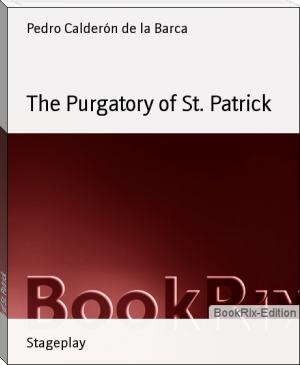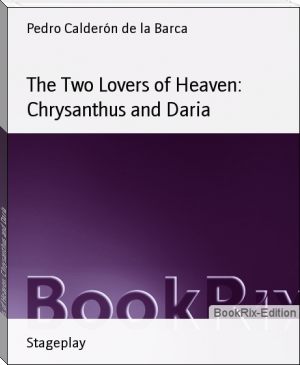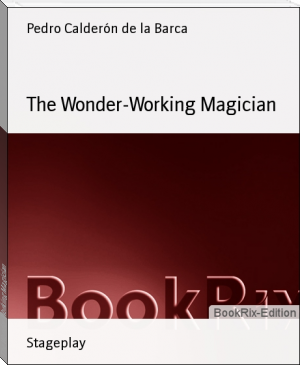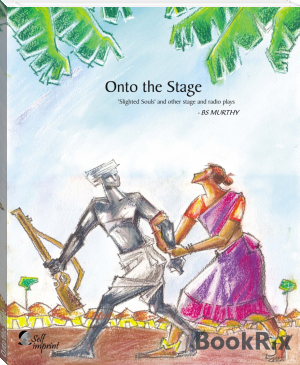The Purgatory of St. Patrick, Pedro Calderón de la Barca [i read a book TXT] 📗

- Author: Pedro Calderón de la Barca
Book online «The Purgatory of St. Patrick, Pedro Calderón de la Barca [i read a book TXT] 📗». Author Pedro Calderón de la Barca
his prettie mouth gives him the first hansel of his sworde upon the very point of the weapon, praying (according to the manner of their country) that he may not otherwise come to his death, than in Battel and among weapons."- 'The Excellent and Pleasant Worke of Julius Solinus Polyhistor. Translated out of Latin into English by Arthur Golding, Gent.' At London, 1587. p. 105.
The last name in the list of authorities on the subject of St. Patrick's Purgatory is "Mensignano," with the reference in the margin of Montalvan's 'Vida y Purgatorio' to his 'Florilegium'. This of course is Messingham, out of whose book, aided by his own wild imagination, Perez de Montalvan created the character of Luis Enius, who is presented to us with such dramatic power by Calderon.
Notwithstanding the length of these notes, the following summary, taken with some corrections from the Introduction to the former translation of this drama (1853), may still be useful:-
The curious history of Luis Enius, on which the principal interest of the play depends, has been alluded to, and given more or less fully by many ancient authors. The name, though slightly altered by the different persons who have mentioned him, can easily be recognised as the same in all, whether as Owen, Oien, Owain, Egan, Euenius, or Enius. Perhaps the earliest allusion to him in any printed English work is that contained in Ranulph Higden's "Polychronicon," published at Westminster, by Wynkin de Worde, in 1495: "In this Steven's tyme, a knyght that hyght Owen wente in to the Purgatory of the second Patrick, abbot, and not byshoppe. He came agayne and dwelled in the abbaye of Ludene of Whyte Monks in Irlonde, and tolde of joye and of paynes that he had seen." The history of Enius had, however, existed in MS. for nearly three centuries and a half before the Polychronicon was printed; it had been written by Henry, the monk of Saltrey in Huntingdonshire, from the account which he had received from Gilbert, a Cistercian monk of the Abbey of the Blessed Virgin Mary of Luden, or Louth, in Lincolnshire (Colgan, 'Trias Thaumaturgae', p. 281. Ware's 'Annals of Ireland', A.D. 1497). Colgan, after collating this MS. with two others on the same subject which he had seen, printed it nearly in full in his 'Trias', which was published at Louvain, A.D. 1647, where with the notes it fills from the 273rd to the 281st page. Messingham, as we have seen, had printed it earlier from other sources, in 1624. Matthew Paris, however, had before this, in his History of England, under the date 1153, given a full account of the adventures of Oenus in the Purgatory, and in the few places that I have compared his account with that given in Colgan, I find both generally agreeing in substance, though not in words. In the folio edition of Mathew Paris, London, 1604, the history of Oenus begins at the 72nd and ends at the 77th page. In Montalvan's life of St. Patrick, the adventures of Enius are given much more fully than either in Matthew Paris or Colgan. In their versions of the story the early life of Enius, previous to his undertaking to enter the Purgatory, is passed over with a few general remarks as to its extreme wickedness - while they give in great detail all that he saw and heard therein. Matthew Paris, for instance, opens the story of Enius in these words: "Miles quidam Oenus nomine, qui multis annis sub Rege Stephano militaverat - licentia a Rege impetrata, profectus est in Hyberniam ad natale solum, ut parentes visitaret. Qui cum aliquandiu in regione illa demoratus fuisset coepit ad mentem reducere vitam suam adeo flagitiosam: Quod ab ipsis cunabulis, incendiis semper vacaverat et rapinis, et quod magis dolebat, se ecclesiarum fuisse violatorem et rerum ecclesiasticarum invasorem praeter multa enormia quae intrinsecus latebant peccata," etc. - 'Mat. Par'., p. 72. In Henry of Saltrey's account, as given by Messingham in 1624 and Colgan in 1647, this portion of the life of Enius is despatched even with more succinctness, but in Montalvan's 'Vida y Purgatorio de San Patricio', all his early crimes are detailed nearly in the order and almost in the very words that Calderon has used. Sir Walter Scott mentions, in his Border Minstrelsy, that there is a curious MS. Metrical Romance, in the Advocates' Library of Edinburgh, called, "The Legend of Sir Owain," relating his adventures in St. Patrick's Purgatory; he gives some stanzas from it, descriptive of the knight's passage of "The Brig O'Dread;" which in the legend, is placed between Purgatory and Paradise. This poem is supposed to have been written late in the thirteenth century. It was printed for private distribution in Edinburgh, in 1837, but from the very limited impression, there having been but thirty-two copies struck off, it must always remain extremely scarce. A cognate work, however, "The Visions of Tundale" (Edinburgh, 1843), published by the same lamented scholar (Mr. Turnbull) who edited the former work, though rare, is more accessible.
THE END.
Imprint
The last name in the list of authorities on the subject of St. Patrick's Purgatory is "Mensignano," with the reference in the margin of Montalvan's 'Vida y Purgatorio' to his 'Florilegium'. This of course is Messingham, out of whose book, aided by his own wild imagination, Perez de Montalvan created the character of Luis Enius, who is presented to us with such dramatic power by Calderon.
Notwithstanding the length of these notes, the following summary, taken with some corrections from the Introduction to the former translation of this drama (1853), may still be useful:-
The curious history of Luis Enius, on which the principal interest of the play depends, has been alluded to, and given more or less fully by many ancient authors. The name, though slightly altered by the different persons who have mentioned him, can easily be recognised as the same in all, whether as Owen, Oien, Owain, Egan, Euenius, or Enius. Perhaps the earliest allusion to him in any printed English work is that contained in Ranulph Higden's "Polychronicon," published at Westminster, by Wynkin de Worde, in 1495: "In this Steven's tyme, a knyght that hyght Owen wente in to the Purgatory of the second Patrick, abbot, and not byshoppe. He came agayne and dwelled in the abbaye of Ludene of Whyte Monks in Irlonde, and tolde of joye and of paynes that he had seen." The history of Enius had, however, existed in MS. for nearly three centuries and a half before the Polychronicon was printed; it had been written by Henry, the monk of Saltrey in Huntingdonshire, from the account which he had received from Gilbert, a Cistercian monk of the Abbey of the Blessed Virgin Mary of Luden, or Louth, in Lincolnshire (Colgan, 'Trias Thaumaturgae', p. 281. Ware's 'Annals of Ireland', A.D. 1497). Colgan, after collating this MS. with two others on the same subject which he had seen, printed it nearly in full in his 'Trias', which was published at Louvain, A.D. 1647, where with the notes it fills from the 273rd to the 281st page. Messingham, as we have seen, had printed it earlier from other sources, in 1624. Matthew Paris, however, had before this, in his History of England, under the date 1153, given a full account of the adventures of Oenus in the Purgatory, and in the few places that I have compared his account with that given in Colgan, I find both generally agreeing in substance, though not in words. In the folio edition of Mathew Paris, London, 1604, the history of Oenus begins at the 72nd and ends at the 77th page. In Montalvan's life of St. Patrick, the adventures of Enius are given much more fully than either in Matthew Paris or Colgan. In their versions of the story the early life of Enius, previous to his undertaking to enter the Purgatory, is passed over with a few general remarks as to its extreme wickedness - while they give in great detail all that he saw and heard therein. Matthew Paris, for instance, opens the story of Enius in these words: "Miles quidam Oenus nomine, qui multis annis sub Rege Stephano militaverat - licentia a Rege impetrata, profectus est in Hyberniam ad natale solum, ut parentes visitaret. Qui cum aliquandiu in regione illa demoratus fuisset coepit ad mentem reducere vitam suam adeo flagitiosam: Quod ab ipsis cunabulis, incendiis semper vacaverat et rapinis, et quod magis dolebat, se ecclesiarum fuisse violatorem et rerum ecclesiasticarum invasorem praeter multa enormia quae intrinsecus latebant peccata," etc. - 'Mat. Par'., p. 72. In Henry of Saltrey's account, as given by Messingham in 1624 and Colgan in 1647, this portion of the life of Enius is despatched even with more succinctness, but in Montalvan's 'Vida y Purgatorio de San Patricio', all his early crimes are detailed nearly in the order and almost in the very words that Calderon has used. Sir Walter Scott mentions, in his Border Minstrelsy, that there is a curious MS. Metrical Romance, in the Advocates' Library of Edinburgh, called, "The Legend of Sir Owain," relating his adventures in St. Patrick's Purgatory; he gives some stanzas from it, descriptive of the knight's passage of "The Brig O'Dread;" which in the legend, is placed between Purgatory and Paradise. This poem is supposed to have been written late in the thirteenth century. It was printed for private distribution in Edinburgh, in 1837, but from the very limited impression, there having been but thirty-two copies struck off, it must always remain extremely scarce. A cognate work, however, "The Visions of Tundale" (Edinburgh, 1843), published by the same lamented scholar (Mr. Turnbull) who edited the former work, though rare, is more accessible.
THE END.
Imprint
Publication Date: 05-20-2008
All Rights Reserved
Dedication:
Translator Denis Florence MacCarthy
Free e-book «The Purgatory of St. Patrick, Pedro Calderón de la Barca [i read a book TXT] 📗» - read online now
Similar e-books:





Comments (0)